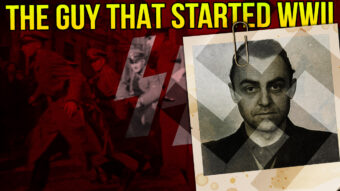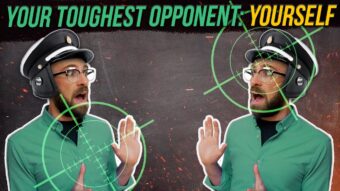
Poland had been high on Adolf Hitler list of grievances since taking power in Germany in 1933. On June 28, 1919, in the wake of the First World War, the victorious Entente powers forced a defeated Germany to sign the Treaty of Versailles, which saddled the country with the sole responsibility for starting the war and a series of harsh concession. The country was forced to pay the modern equivalent of $33 billion in reparations, forbidden from having an air force or a standing army larger than 100,000 men, and stripped on 65,000 square kilometres of territory and all its overseas colonies. Among these territorial concessions was the creation of the Danzig Corridor, a 50-kilometre-wide strip of land which connected the newly restored Polish Republic to the Baltic coast and completely cut Germany off from its territory of East Prussia.
A popular narrative holds that the terms of the Treaty of Versailles – particularly the monetary reparations – were excessively harsh, and led directly to the hyperinflation of the 1920s, the rise of the Nazis, and the outbreak of the Second World War. Indeed, following the signing of the treaty, Allied Supreme Commander Marshal Ferdinand Foch prophetically declared:
“This is not a peace. It is an Armistice for twenty years.”
In reality, reparations played only a partial role in Germany’s post-war economic troubles, while the reparation payments themselves were cancelled in 1932 after Germany had paid only 5 billion of its $33 billion obligation. Nonetheless, for many Germans the Treaty of Versailles was a national humiliation, and Adolf Hitler ruthlessly exploited this resentment to carry himself and his National Socialist Party to power. Hitler wasted no time reclaiming the territory lost to the Treaty of Versailles. On March 7, 1936, German troops re-occupied the Rhineland, which had been de-militarized since 1919, while on March 12, 1938, the Anschluss unified Germany and Austria into “Greater Germany.” Hitler next laid claim to the Sudetenland region of Czechoslovakia, home to a large minority of ethnic Germans. These claims precipitated an international crisis and brought Europe to the edge of war. In desperation, in September 1938 British Prime Minister Neville Chamberlain flew to Munich and negotiated the handover of the Sudetenland in return for the cessation of German territorial expansion. This compromise infamously backfired, for Hitler, emboldened by the Allied policy of appeasement, proceeded to invade the rest of Czechoslovakia on March 15, 1939. However, as there were hardly any ethnic Germans in this part of Czechoslovakia, the invasion laid bare Hitler’s true intentions. Thus, when he next demanded the return of the Danzig corridor to Germany, the Allied powers were far less willing to negotiate. Hitler therefore turned to the infamous Schutzstaffel or SS – his bodyguard-turned-political paramilitary force – to engineer a series of supposedly Polish attacks along the border to justify the outright invasion and occupation of Poland, scheduled for August 26, 1939. On August 22, as troops were massing at the border, Hitler told his generals:
“I will provide a propagandistic casus belli. Its credibility doesn’t matter. The victor will not be asked whether he told the truth.”
The task of planning these false-flag operations -codenamed Undernehemen Himmler after Heinrich Himmler, head of the SS – fell to Heinrich Müller, chief of the Gestapo secret police, and Reinhard Heydrich, head of the Sicherheitsdienst or SD, the SS intelligence service. Operation Himmler would consist of a series of 21 staged attacks by SS troops dressed in Polish uniforms, carried out against various targets just across the German border, including the railway at the Jablunka [“Ya-bloonk-ah”] Pass, the German customs station at Hochlinden [“Hock-lihn-den”], the railway station at Alt-Eiche [“Ahlt-ike”], and the forest service station at Pitschen. The most elaborate operation, however, would be directed at the radio station at Gleiwitz [Glaye-vits”] in Upper Silesia. Built in 1935 by German electronics firm Lorenz, the complex’s 33-metre-tall antenna mast remains the tallest wooden structure in Europe. Upon seizing control of the station, the SS troops would use the transmitter to broadcast a pro-Polish message across Germany, providing indisputable proof of Polish aggression. And to make this and the other operations look even more convincing, inmates from the Dachau concentration camp would be dressed in Polish uniforms, drugged, shot in the face to prevent identification, and left behind at the scene of the attacks. In a classic example of dark Nazi euphemism, these planted bodies were referred to as konserve or “canned meat,” leading to the common but false claim that the whole operation was code-named Unternehemen Konserve.
The man tasked with leading the attack on the Gleiwitz radio station was 29-year-old SS-Stürmbannführer Alfred Naujocks [“Naw-yocks”], an accomplished amateur boxer and street brawler from the Nazi Party’s earliest days. By 1939 he had become one of Reinhard Heydrich’s most trusted agents and placed in charge of the SD’s foreign section, forging passports, identity cards, money, and other documents for SD agents operating abroad. As Naujocks told a reporter in 1960, Heydrich summoned him to his office and explained:
“Within a month we shall be at war with Poland. The Führer is determined. But first we have to have something to go to war about. We’ve organised incidents in Danzig, along the East Prussian border with Poland, and along the German frontier. But there has to be something big and obvious.”
In mid-August 1939, Naujocks and a squad of six Polish-speaking SS soldiers travelled to Gleiwitz and checked into Oberschlesischer [“Oh-burr-shlay-sick-er”] Hotel, claiming to be mining engineers prospecting for minerals in the area. They then went about assembling the Polish uniforms, documents, weapons, cigarettes and other items they would need to carry out the staged attack. Intimately involved in this procurement process was an unexpected figure: none other than Oskar Schindler, the industrialist who would later go on to save the lives of 1,200 Jews during the Holocaust. In 1939, however, Schindler had yet to have his change of heart, and still actively supported the Nazi war effort. Indeed, this was not even his first collaboration with German intelligence. In 1936 Schindler, broke and desperate following a series of failed business ventures, joined the Abwehr [“Ab-vayr”], the German military intelligence agency, and was assigned to spy on Czech military defences near the town of Ostrava. Unfortunately, Schindler proved an even worse spy than he was a businessman, and was soon arrested, charged with treason, and sentenced to death in August 1938. But before he could be executed, Germany invaded Czechoslovakia and Schindler was freed. He was then promoted by the Abwehr and made deputy commander of intelligence in Ostrava, which was less than 20 kilometres from Gleiwitz. Uniforms and other materials for the Glewitz operation were stored in Schindler’s apartment, while a network of Abwehr agents under his command helped smuggle SS agents across the border into Poland.
By August 25, everything was ready, and Naujocks and his squad awaited the codeword “Grossmutter gestorben” – or “Grandmother has died” – that would set the operation in motion. However, Hitler, sensing that Poland and its allies might soon capitulate to his demands, postponed the invasion to September 1, leaving Naujocks and his men waiting for nearly two weeks. Finally, on the evening of August 31, a phone call bearing the codeword arrived at Oberschlesischer Hotel, and the squad piled into two cars and drove to the Gleiwitz radio station. Also in one of the cars, dressed in a Polish uniform and drugged into unconsciousness, was Fasciszek Honiok, a 43-year-old Upper Silesian farmer who had been arrested by the Gestapo for collaborating with Polish saboteurs.
The squad reached the station around 8 PM and stormed up the stairs and through the front door. They met no resistance from the guards and quickly overpowered both them and the engineers on duty, binding and locking them up in the basement. Fasciszek Honiok’s unconscious body was then dragged from the car, shot through the back of the head, and draped over the front stairs as “proof” of Polish involvement in the raid. But as one of Naujock’s men, Karl Hornack, prepared to make the staged pro-Polish broadcast, he realized he had made a crucial error. The building the squad had raided contained no broadcast studios, only transmitting equipment designed to broadcast signals received via cable from the city of Breslau. After a desperate 10-minute search of the building, Hornack resorted to using emergency storm microphone, designed to warn radio listeners of inclement weather. In perfect Polish, Hornack barked over the airwaves:
“Attention! This is Gliwice. The broadcasting station is in Polish hands.”
Hornack had intended to end the broadcast with a statement about Polish territorial claims in the region, but this part of the message was cut off – either due to technical problems or a Polish technician who managed to shut off the transmitter. But it was enough, and as Naujock’s squad withdrew from the complex, radio stations in Germany rebroadcast the transmission across the country as proof of Polish aggression. The other 20 Operation Himmler attacks were similarly successful – with one major exception. The squad tasked with raiding the Hochlinden customs post was not informed of the delay in the invasion plans and attacked before the post could be cleared, resulting in the deaths of several German citizens. But it hardly mattered: Hitler had his pretext for invasion. The next morning, the Führer gave a speech before the German Parliament or Reichstag, declaring:
“I can no longer find any willingness on the part of the Polish Government to conduct serious negotiations with us. These proposals for mediation have failed because in the meanwhile there, first of all, came as an answer to the sudden Polish general mobilization, followed by more Polish atrocities. These were again repeated last night. Recently in one night, there were as many as twenty-one frontier incidents: last night there were fourteen, of which three were quite serious. I have, therefore, resolved to speak to Poland in the same language that Poland for months past has used toward us… This night for the first time Polish regular soldiers fired on our own territory. Since 5:45 a. m., we have been returning the fire… I will continue this struggle, no matter against whom, until the safety of the Reich and its rights are secured.”
As Hitler spoke these words, the combined might of the German Wehrmacht and Luftwaffe was already storming across the border into Poland. While the Allied powers were not fooled for long, the confusion sown by the Operation Himmler attacks bought Hitler valuable time to complete his invasion unopposed. On September 17, the Soviet Union, with whom Hitler had signed a non-aggression pact, invaded Poland from the east. By October 6, Poland’s fate was sealed, and the stage was set for the most destructive conflict in modern history.
If you liked this article, you might also enjoy our new popular podcast, The BrainFood Show (iTunes, Spotify, Google Play Music, Feed), as well as:
- If Hitler’s Regime was the Third Riech, Who Were the First and Second?
- How Close Did the Nazis Actually Come to Building an Atomic Bomb?
- The Connection Between Saddam’s and Hitler’s Bunkers, Why Your Friends are Likely to Have More Friends Than You, and More, in Yet Another 10 Quick Facts
- The Women Who were Used for Breeding by the Nazis
Graham, Bob, World War II’s First Victim, The Telegraph, August 29, 2009, https://web.archive.org/web/20120314190818/http://www.telegraph.co.uk/history/world-war-two/6106566/World-War-IIs-first-victim.html
Gliwice Radio Status, Museum on Radio History and Visual Arts, https://web.archive.org/web/20061104063227/http://www.muzeum.gliwice.pl/en/radiostacja/
Lebovic, Matt, 80 Years Ago, How a Very Different Schindler’s ‘List’ Helped Ignite WWII, The Times of Israel, August 30, 2019, https://www.timesofisrael.com/80-years-ago-how-a-very-different-schindlers-list-helped-ignite-wwii/
Pope, Cassie, How a False Flag Sparked World War Two: the Gleiwitz Incident Explained, History Hit, August 31, 2018, https://www.historyhit.com/gleiwitz-incident-explained/
Carlson, Cody, This Week in History: Nazis Stage Fake Attack at the Start of WWII, Deseret News, September 3, 2014, https://www.deseret.com/2014/9/3/20547775/this-week-in-history-nazis-stage-fake-attack-at-the-start-of-wwii
Dowell, Stuart, How the Death of a Farmer and a Bungled Siege of a Radio Tower Gave Hitler His Justification to Unleash WWII, The First News, September 1, 2020, https://ift.tt/XWE5jU7
The post Forgotten History- That Time Hitler had His Agents Secretly Attack Germany in Order to Justify Starting WWII appeared first on Today I Found Out.



0 comments:
Post a Comment
Please ,
Don't enter span link